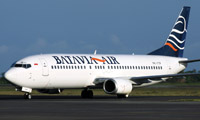Low-Cost Carriers
OPPORTUNISTS
AirAsia moves base to Indonesia to keep one step ahead of its rivals
September 1st 2012
AirAsia Group chief executive, Tony Fernandes, knows no business can rest on its laurels. Last month, he emphasized the point as he launched the Malaysian budget carrier’s seventh no-frills brand, AirAsia ASEAN, in Jakarta, the location of his new regional head office. Read More »
 |
| 'ASEAN is a massive market where we only scratch the surface. We need to grow from the inside' |
| Tony Fernandes Chief Executive AirAsia Group |
“ASEAN is a massive market where we only scratch the surface. We need to grow from the inside,” said Fernandes, the founder of the region’s largest low-cost carrier (LCC).
“Shifting AirAsia’s emphasis to a regional strategy is, we believe, not just good business, but also a move that will keep us ahead of the inevitable competition that is heading our way.”
Qantas’ Jetstar, Indonesia’s Lion Air, the Philippine’s Cebu Pacific, Singapore’s Tiger Airways, India’s Indigo and numerous others are hot on AirAsia’s heels. They have hundreds of narrow-bodied jets on order that promise to bring unprecedented budget capacity to the Asia Pacific’s skies.
It August, the LCC pioneer launched AirAsia Japan, but Fernandes sees the 10-nation ASEAN bloc (Association of Southeast Asian Nations), which is aiming for full open skies in 2015, as the jewel in the group’s crown. “Our mandate in the next five or six years is to focus on ASEAN,” he said. Fernandes and his deputy, Kamarudin Meranun, are now based at the AirAsia ASEAN office in Jakarta, which is home to the ASEAN Secretariat.
That move, along with a decision last month to spend $80 million acquiring a controlling stake in local Indonesia operator, Batavia Air, may have surprised some, but the figures speak for themselves.
Demand for air travel in Indonesia, an archipelago of more than 17,000 islands with a growing middle class among its 240 million population, has been soaring. Last year, 60 million Indonesians took to the skies, a 15% increase from 2010, according to the Ministry of Transportation.
International passenger traffic grew 23% to eight million. Jakarta’s main hub, Soekarno-Hatta International Airport, built to handle 22 million passengers, now caters for more than 50 million. According to Airports Council International, it is the fastest-growing airport in the world. As Fernandes put it: “Indonesia is like a planet. There is lots of room to grow.”
He is convinced a key to success is consolidating aggressive growth plans within ASEAN before fully taking on larger markets such as China and India.
Fernandes emphasized that by expanding within ASEAN, and with Jakarta as the new command centre for strategic planning, the carrier was expanding its market base to 601 million people and bringing ASEAN closer - within a four-hour flight radius – of big populations in China, India, Japan and South Korea.
 |
| Batavia Air: AirAsia is bidding for a 76% share of the Indonesian carrier |
ASEAN, along with Northeast and South Asia, have a combined population of three billion, or 43% of the world’s population, he pointed out.
The AirAsia Group, which includes AirAsia, Thai AirAsia, AirAsia Philippines, AirAsia Indonesia, AirAsia Japan, AirAsia ASEAN and long-haul AirAsia X, has a fleet of 104 A320s, nine A330s and two A340s operating 160 direct city-to-city links to 85 destinations, including 55 in ASEAN.
Passenger volumes surged from 22.1 million in 2009 to 24.4 million in 2010 and 30 million last year. It has a fleet expansion programme that includes firm orders for 375 A320s, 25 A330s and 10 A350s.
Last month, AirAsia X signed a 10-year, $500 million lease deal with US-based International Lease Finance Corp (ILFC) for six A330s as it seeks to nearly triple its passengers to seven million by 2014. It operates 11 jets and will take delivery of 17 new A330-300s by 2017.
“We want to make sure we are completely ahead of the game,” said chief executive, Azran Osman-Rani. The new planes will be used to increase flight frequencies and add new destinations in its core markets of Australia, China, Japan and South Korea.
AirAsia X withdrew from Europe (London and Paris) because of rising fuel costs, weakening demand caused by the European economic conditions and high taxes. Fernandes said there were no plans for the carrier to return to Europe.
Last year, the group posted record revenue of $1.4 billion, up 13% on 2010, with net income of $281.2 million, 18% higher than the previous year. “This is remarkable in an environment where macro-economic factors such as fuel prices have impacted us and every other airline,” said Fernandes.
“Average fuel prices increased 36% over the year. Even though fuel costs make up 50% of our total cost, our resilient business model, focus on cost control and an efficient operation has enabled us to sustain high margins.”
|
The Association of Southeast Asian Nations (ASEAN) comprises |
AirAsia posted a 4% increase in first quarter (ended March 31) net profit to $53.4 million on record quarterly revenue of $373.5 million in what is traditionally the weakest quarter of the year.
While the main focus is on the ASEAN region, AirAsia will not let other opportunities slip by. Fernandes disclosed that AirAsia Japan (67% owned by Japan’s largest carrier, All Nippon Airways, and AirAsia 33%) was one such opportunity. “Japan was not in my strategic plan, but it appeared at my doorstep and we do not throw an opportunity like that away,” he said.
The decision to purchase Batavia, was another case in point. “In general, I am not a believer in acquisition. I believe in organic growth,” said Fernandes. “But if opportunities arise, then we will look at it.”
The acquisition of Batavia Air, which is presently under the scrutiny of Indonesia’s Business Competition Supervisory Commission, has yet to be finalized. If given the green light AirAsia will purchase 76% of the Indonesian carrier in two phases.
Batavia, with a fleet of 30 aircraft, commands a market share of 11.25% in Indonesia, carrying 6.75 million passengers domestically. It flies internationally to Jeddah in Saudi Arabia, Singapore and Guangzhou in southern China. It has been in financial trouble recently and was forced to return two leased B737s after failing to pay overdue bills.
The transfer of AirAsia’s corporate offices to Jakarta was prompted by the collapse of the carrier’s share swap deal with Malaysia Airlines (MAS) in May. That deal unwound following objections from MAS unions, said Fernandes.
“That woke me to the potential of AirAsia. If I had put in the same energies for MAS into regional development, just imagine the possibilities,” he said.
As part of its ASEAN expansion, AirAsia plans to so set up pilot training centres in several locations such as Batam in Indonesia, Penang in Malaysia, Thailand and Singapore.
So what next for AirAsia? Africa maybe? The group’s entrepreneurial leader has already made mention of the possible potential the continent holds for LCCs. Watch this space.